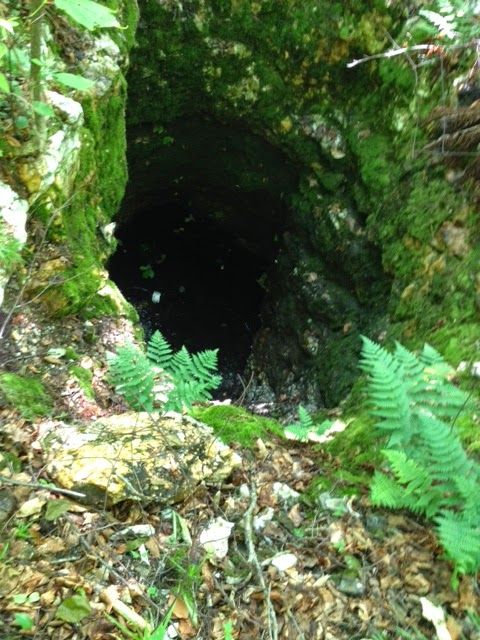Visiting the Cushman Cemetery is much easier, now that it's been trimmed and mowed -- a late-autumn caretaking gift (it would be nice to know who did this, to thank you!). It's a peaceful little family cemetery at the edge of a cornfield near the end of East Village Road.
This material describing the stones is per UPPERCONNRIVER and given at the website http://freepages.genealogy.rootsweb.ancestry.com/~upperconnriver/Waterford/Cushman/Cushman.htm and I am grateful for permission to share it from the site (but please do check in now and then at the original website to see any changes added).
[I am aware that the town selectboard hopes to replace the earlier fence in order to rehang this nice old gate. -- BK]
Cushman Family Cemetery, East Village Rd,
Waterford, Caledonia County, Vermont, USA
databased 2008 by Robert Goss
verified & corrected 2008
by me [Robert Goss].
Stones are oriented so as to be readable when facing the surounding stone walls.
To reach this cemetery, turn off US Rte 2 in East St Johnsbury, cross the river onto East Village Rd (TR#4), bear right at the fork, follow this road about 1.1 mi to the "end". There appears to be a left-curve here, but it is actually TR#5, (TR#4 once continued straight thru Blodgett's mailbox into the trees and down the backside of Moose River into Concord, joining Cross Rd near the old fairground - it is now discontinued). You can see the cemetery to your left across the field; please walk next to the stone wall when the hay [corn] is growing.
This is a family cemetery that is no longer maintained. It was turned over to the town for maintenance in 1980 as it was no longer convient for the family to care for it.
Stone #8 appears out-of-place because the burial took place after Eugenia completed her transcript and map.
NOTE: a slash "/" indicates the end of a line of engraving on the gravestone.
DOBs followed by an "a" are calculated from the DOD on the stone minus the AGE on the stone.
italics indicate the info is from other vital or town records; but, not actually on the stone.
| Cem+ StoneNum |
LastName | FirstName | Maiden | DOB | DOD | Spouse/Parents | Add'l Info |
|---|---|---|---|---|---|---|---|
| CU+0.1 | A white marble stone, 2" above ground, 6" wide, 2" thick, split into two 1" thick pieces - no lettering seen. | ||||||
| CU+0.2 | P | B | A white marble stone, 6" high, 6" wide, 2" thick - like a footstone, initials "B. P.". | ||||
| CU+1.1 | Reed | Nichols S. | 01/__/1830a | 7/15/1855 | Aged 25 y'rs 6 mos. White marble with low angle top, square name band, plain, lettering is on the west side facing the back wall, grave is to the east of the stone. Stone is about 5' tall and has been down for years, it was found buried (in 2008) under 3" of thick hay thatch and has weathered so badly that it is barely readable. | ||
| CU+1.2 | Reed | Mariah L. | 1/01/1826 | 10/01/1899 | Aged 73 yrs 9 mos. Same as above except square name band has tracery, marble has darkened more, & veins are more pronounced. | ||
| CU+1.3a | Reed | Milo | 03/__/1851a | 10/15/1851 | children of N. S. and M. L. Reed | AE 7 mos. 18" high, grayed white marble, square name band, plain. | |
| CU+1.3b | Reed | Azelia | 1/27/1854a | 2/16/1854 | children of N. S. and M. L. Reed | AE 3 weeks. 18" high, grayed white marble, square name band, plain. | |
| CU+2.1 | Russell | George S. | 10/__/1823a | 6/08/1910 | AE 86 yrs 8 mos. Matches #2.2; six inches thick with wide bevel at top and taper down side. Leaf design on top bevel with an X in the middle (crossed stems??), line tracery on side bevel, curved name band with line tracery background and fancy inside edge, then there is a double size double marble base for both stones. Parents of Mrs. Emma Cushman ?? Alpheus Bugbee settled in this part of town in 1800. Russell and Reeds are Concord and Kirby names. | ||
| CU+2.2 | Russell | Emma L. | Bugbee | 12/__/1822a | 7/04/1908 | wife of George S. Russell | AE 85 yrs 8 mos. Stone matches #2.1 |
| CU+2.3a | Cushman | Edgar O. | 1854 | 1925 | Gray granite monument with name on the face. Corner rose design, 12" thick, smooth but not polished. | ||
| CU+2.3b | Cushman | Edna L. | Russell | 1852 | 1946 | his wife {of Edgar O. Cushman] | |
| CU+2.4 | McGregor | Almyra | 10/__/1802a | 10/03/1843 | wife of John McGregor | AE 41 yrs. Two and one half feet high, perfectly plain with square top. All the lettering slants forward, whether cursive or another style, except for her name. | |
| CU+2.5 | McGregor | John | 1800a | 08/__/1848 | AE 48. Same style except thicker. Straight lettering except verse which is a small script, "How brief is life--how long eternity". | ||
| CU+2.6 | Bugbee | Hannah | 1798 | 8/26/1876 | Aged 78 yrs. Heavy very much darkened gray granite markers which may replace original stones, about 15" tall and 20" wide. Pillow shaped with lettering on a somewhat convex face. | ||
| CU+2.7 | Bugbee | Olive | 1794 | 1866 | Aged 72 yrs. Stone matches #2.6. | ||
| CU+2.8 | Cushman | Russell B | 1907 | 1980 | Modern grass-high, gray granite marker. |

















































